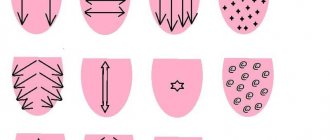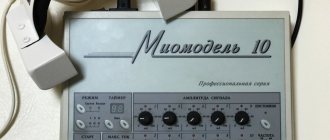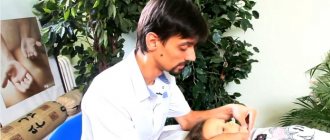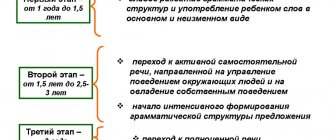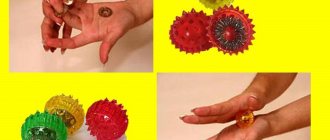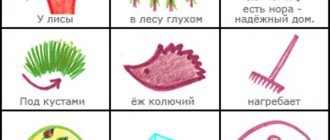“The white-sided magpie was cooking porridge and feeding the children.” Remember the words of the children's nursery rhyme? Can you name the finger that didn't get the porridge? If yes, then you are already familiar with finger massage techniques for children. It is believed that it needs to be done from the first days of life so that the child develops speech correctly. Let's figure out whether this is really so and how to massage children of different ages.
Why do finger massage?
The first two years of life play a very important role in the development of a child. At this time, the baby develops cognitive abilities: memory, the ability to perceive and analyze information, as well as transmit it through speech, gestures and movements. Therefore, communication with mom and other close, loving people is necessary for the baby just like food, warmth and healthy sleep. Until the baby learns to speak, this communication will be primarily tactile. When you hug, tickle or pet your baby, you stimulate his sensory receptors - nerve endings that send signals to the brain and make it work.
There are a lot of receptors on the baby’s arms, and the areas in the cerebral cortex that are responsible for fine motor skills of the hands and speech are very close and have areas of overlap. This means that when you touch your baby's fingers and hands, you are training his cognitive abilities.
What is motor skills
This is the motor activity of any organ or part of the body. When talking about fine motor skills, we mean the hands and fingers – i.e. a person’s ability to grasp and hold small objects and manipulate them. If a child has poorly developed fine motor skills, toys will constantly fall out of his hands, he will not be able to hold a spoon normally, will have difficulty tying shoelaces, etc.
This will lead to problems in the future. An adult with poorly developed fine motor skills will have ugly handwriting. He is unlikely to learn how to quickly type on a computer. Will not be able to drive a car due to the inability to coordinate and place one hand on the steering wheel and the other on the gearbox.
By the way! People with poor fine motor skills have imperfect speech apparatus. Such a person will not become a good speaker, so it will be difficult for him to study and will not be able to master professions where correct speech is needed (teacher, tour guide, PR manager, event host, etc.).
When should you start finger massage of your child’s hands?
Hands need to be massaged from birth. True, for now it will be little like a real massage. Light stroking and pressing are enough, as well as exercises to develop the grasping reflex: just bring your finger or small toys to the child’s hands so that he can grab them.
When the child turns one year old, you can move on to nursery rhyme games. For example, the familiar “White-sided Magpie”. Read a poem to your baby: while the magpie is preparing porridge, move your index finger in a spiral along your palm, and when the bird starts feeding the chicks, bend the baby’s fingers one by one. Such activities engage surface receptors on the child’s hands. Thanks to the fact that you pronounce all the actions, the baby at the same time learns to connect your speech with actions and objects.
From the age of two we begin to move on to massage that stimulates deep pressure receptors. To do this, you can use massage balls with pimples, which need to be rolled over the child’s palms and fingers, pressing lightly. At this age, the baby is already able to perform exercises to develop fine motor skills: grab and touch small objects. It is important that he does this under adult supervision, because the baby may want to see if he can fit this part into his nose or ear.
For school-age children who begin to write unusually a lot, it is useful to have a relaxing hand massage. To do this, massage the child’s hand with circular squeezing movements from the back, then pay attention to each finger and also massage from the nail to the base. After this, use your thumbs to massage the baby’s palm in a circular motion.
It is useful to teach your child how to do this massage on his own, so that he can use it if his hands get tired during lessons or doing homework. If he still can’t remember all the movements, teach him the game “We wrote, we wrote, our fingers were tired.” Let him clench and unclench his hands into a fist for a few seconds, this also helps to relax his hands.
The Nyagan Rehabilitation Center provides comprehensive diagnostics and rehabilitation of children with various developmental problems. In case of delayed speech development, rehabilitation is comprehensive and is selected individually for each child. In this case, speech, motor, sensory or cognitive centers are selectively activated. The medication component, selected individually, increases the rate of progress in such children. Massage for delayed speech development is an important element in the treatment of a child. There are several massage methods and each of them stimulates a specific area. What kind of massage should be given to a child with delayed speech development? All types of massage can be divided into several categories:
1. Speech therapy massage;
2. Massage of palms and arms;
3. Facial massage - forehead, cheeks, mouth and chin;
4. Massage of the collar area.
Palm massage is quite effective in dealing with speech delays. Usually it is carried out independently by parents or children. It can be divided into active and passive. Passive is performed by parents or a doctor; as a result of the massage, areas on the palms and fingers of children are worked out. Both the outer and inner parts of the palm, as well as the area up to the elbow, are massaged. Just 15 minutes is enough to stretch these areas. In order for the child to calmly perceive the massage, it is carried out in a playful way, supplemented with poems and nursery rhymes.
For delayed speech development, massage of the neck, shoulder blades, and collarbones is quite effective. It is prescribed not only for stimulation, but also for general improvement of the body’s condition. A common cause of delayed speech development is birth trauma, as well as pinched nerves in the neck. Massage improves blood circulation in the brain area, thereby stimulating the development of the speech apparatus. During the massage, all muscles, as well as the brain, are saturated with oxygen.
How to massage the collar zone with delayed speech development. Usually the massage session is not very long, only 20 minutes. Please note that it is performed without pain or strong pressure. Consists of approximately 20 sessions. It is recommended to repeat after 2 months. When performing a massage, the child is laid on his stomach, with his arms along the body. The massage begins with light stroking, movements from top to bottom, in the neck area.
Afterwards, you can increase the pressure and perform rubbing movements in this area, but with three phalanges of your fingers. Next, a massage is carried out on the muscle that is located between the neck and shoulders. It is necessary to work not only the neck, but also the upper back.
It is worth noting that speech therapy and speech massage is quite useful, but in order for it to give a good result, it should be combined with breathing and voice exercises.
It is necessary that a child associate massage not with something painful, but with pleasant manipulations. There are a lot of techniques that will be perceived by a child not as treatment and procedures, but as entertainment and games.
Author: Irina Viktorovna Glotko, massage nurse
How to prepare for a massage?
First, warm and stretch your hands. To do this, you can rub your palms together, clench your fists, or hold your hands under running warm water. Make sure that there are no wounds or hangnails on your hands; you will also have to give up manicure with long nails. If the skin on your hands is dry, use a hypoallergenic cream that your baby is used to. When massaging a child in the first year of life, you should not choose essential oils. Choose proven products.
If you notice wounds or allergic rashes on your child’s hands, postpone the massage until they heal or first treat the baby’s skin with a special allergy cream or ointment. After this, you can begin the massage, but do it even more carefully and carefully than usual.
Babies are not always happy about massage. You should not do it if the child is upset or capricious. The procedure should bring him joy and pleasure. Children as young as one year old may have problems with concentration and perseverance during classes. Therefore, turn the process into an exciting game with rhymes, songs and toys and do not prolong the exercise. A few minutes a day for massage is enough.
Contraindications
You can do the exercises listed above at least every day. There will be no harm from this only if the child has no contraindications. And this:
- minor injuries on the hands (wounds, sores);
- rashes;
- fungal diseases;
- bad feeling;
- general inflammatory or infectious disease.
Hand massage and finger exercises not only develop motor skills, but also bring other benefits. They improve concentration, develop imagination (especially finger games), strengthen trusting relationships with parents and stimulate speech development.
Where can you find ideas for educational games with your child?
If the rhyme about the white-sided magpie no longer captivates your child, new nursery rhymes can be found on the Internet or in books. We've selected three titles that will inspire new ideas for games to develop fine motor skills.
“Finger games. The white-sided magpie was cooking porridge.” The book contains nursery rhyme games with detailed illustrations of how to do the exercises, as well as ideas for organizing a finger theater with children.
“Fun educational games. From birth to three years.” The author of the book, Sally Goldberg, explains how a child's brain and cognitive abilities develop at an early age, and gives exercises that help with this.
"Open and close." Biologist Lucy Felix came up with and drew a book in which a child follows the adventures of a white mouse, and at the same time does exercises for fine motor skills and learns colors and shapes.
Development of fine motor skills using improvised tools
In the modern world, the industry has undoubtedly expanded greatly: there is a large amount of literature for the development of fine motor skills, but their cost is not budgetary. During the lesson it is possible to use items made independently.
The first thing you can introduce your baby to is lacing. To make the game, you will need cocktail tubes, which you need to cut into small pieces and thread the string inside. It is allowed to thread the lacing into the tubes randomly, but with older children, you can complicate the task by coming up with a certain sequence, sorting the tubes, alternating them by color.
Don't throw away your old markers, you'll really need them too. After disconnecting the caps from the markers, try to put them back on with your child. This is a great color vision task. It is advisable to remove the remaining ink rod when playing.
Use a quail testicle cell. From the reverse side, decorate the cell with acrylic paints of primary colors. Make quail-size eggs in the appropriate colors from salt dough or plasticine. Invite the little one to arrange the eggs by color, in certain cells. Testicles are a good visual material for teaching counting.
Next, let's look at a tool such as clothespins. They can be purchased at any hardware store. And now, fortunately for all teachers and parents, they have appeared in the main color scheme. Make a sun out of cardboard. Can be used to study emotions. “The sun became sad without its rays. Let's make some rays for the sun. What happened? It started smiling!” On the reverse side draw a cheerful luminary.
Read more: How to cope with the fact that your future child is of the “wrong” gender?
The same work can be done with carrots. “Our carrots were sad, they were in the garden. She really wanted to go out into the world.” Let's attach green clothespins - grass - to the orange beauty. Look how happy the carrot has become!
Let's make a bird out of cardboard. You can ask your child to attach a sparrow's tail and wings so that the bird can fly. This exercise will expand the child’s understanding of existing birds.
For the youngest kids, use mosaic. How can it be used? The mosaic was created for children from three years old, as it contains small details. Of course, you need to play only under the strict guidance of adults. Make sure that the baby does not pull small parts into his mouth.
All templates are easy and simple to make. For this age period, your artistic skills, for a baby, are in a secondary place, so everything can be done simply in silhouette.
It is important to organize the game situation. “A cloud flew in. It was pouring rain. Droplets dripped onto the ground “drip-drip.” Invite the little one to make raindrops.
The kids really like the mosaic “Spring Tree”. When placing green leaves on the tree, recite the nursery rhyme:
Spring has come to visit us, bringing greenery to all the trees. The birds sang cheerfully, the rays warmed their houses. The bees flew into the hives, ate well on the flowers, and the birch trees wore dresses for weeks, so that the leaves rustled quietly
In cases of autumn weather, you can make a tree with red, yellow or orange leaves.
Autumn gave bright colors. Red, red, gold, All the colors are now with me! I will collect them together, And I will braid the trees.
Place the cut out basket on the mosaic. Ask the little one to fill a basket for Mikhail Potapovich.
Misha walked through the forest. He found some mushrooms. Strawberry, jump into the tub. Bear will eat it on the sly.
It’s very good if you have a bibabo toy. The guys like to have a dialogue with them. Be sure to lead the conversation away from the toy. The little bear should try the berries that the child picked for him and thank the baby for his good work.
To develop color perception, you can make a circle with birds of different colors. Use wooden clothespins and paint the ends with matching colors. Involve your little one in making tails for the birds.
The birds have flown in, they are singing songs, we are singing happily together, we are pecking at delicious grains.
Templates can be made from colored paper and applied to the mosaic or attached using stationery mastic.
Read more: Combining activities for children of different ages
Execution technique
The effectiveness of massage largely depends on the correct execution of the technique. The procedure is carried out as follows:
- Finger massage . The patient places his hand on a special roller and relaxes the hand muscles as much as possible. The massage therapist fixes the hand with one hand and massages the fingers with the other, starting with stroking. Then he proceeds to rubbing in the transverse and longitudinal direction. At the end, the fingers are withdrawn and brought together.
- Hand massage . The position of the hand is the same as when massaging the fingers. First, the massage therapist will stretch the fingers and then move on to the palm part. Use your thumb and index finger to warm up the skin and work each tendon. Stroking and kneading are also carried out. The massage also ends with the fingers moving in and out.
- Forearm massage . The procedure begins with stroking from the fingertips to the wrist joint. The forearm and wrist are treated with continuous stroking. Then shaking is carried out if the patient does not have injuries or any contraindications.
During a manicure massage, the figure eight exercise is also performed. The hand is placed on the table, palm up. You need to draw the number 8 with your finger on the surface of your palm, pressing on the skin, but without causing pain.
To make your hands glide better, special creams and oils are used, but they need to be applied in small quantities, otherwise your fingers will slip and you won’t be able to apply the necessary pressure to the active points. When performing a manicure massage, it is recommended to exfoliate or treat the skin with a scrub before the procedure.
Massaging hands and fingers is carried out without gloves, so the specialist must not only wash his hands before starting the procedure, but also treat them with an antiseptic.
II. Types of massage
The field of speech therapy is so developed today that listing all the techniques would require writing a huge book. We will talk about the main techniques that are most often used in logotherapy.
Five main types of logomassage:
- classical;
- spot
- hardware;
- self-massage;
- probe
The classic to the usual manual facial massage - stroking, rubbing, kneading, etc.
To perform acupressure, you need to know the “active” points of the body, that is, this procedure requires special knowledge.
You can massage your body using a medical device - this will be a hardware massage .
Self-massage is performed by a child - for this he needs to be taught how to bite his tongue and massage his face correctly.
The probe allows you to reach remote parts of the articulation organs and thereby activate their work.
Massage can be aimed at relaxing or activating the speech organs. If you want to relax your muscles, try to press lightly, use sliding movements. If you decide to activate the muscles and add tone to them, massage deeply and energetically.
For various types of logomassage, spoons, toothbrushes, spatulas and probes are used.
